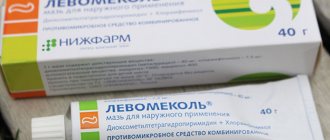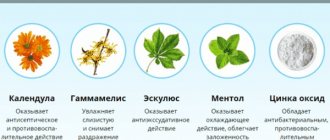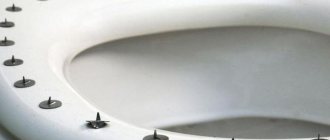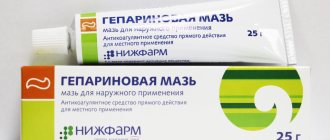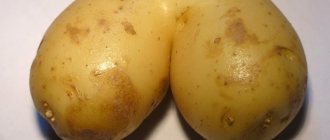- Composition of Vishnevsky ointment
- Medical indications for use
- Methods of using Vishnevsky ointment
- Vishnevsky ointment for acne
- Vishnevsky ointment during pregnancy
- Vishnevsky ointment for infertility
- Vishnevsky ointment for hemorrhoids
- Arguments against Vishnevsky ointment
| Vishnevsky’s ointment, or among the scientific community, balsamic liniment according to Vishnevsky, is a drug that is created to effectively combat various types of harmful microorganisms. Each of us knows the ointment and remembers it by its specific, persistent smell. |
Composition of Vishnevsky ointment
The composition of the “queen” of ointments was developed by the famous Russian surgeon Alexander Vasilyevich Vishnevsky. The ingenious recipe included three main ingredients: birch tar, xeroform and castor oil. Tar, oil and xeroform, when combined, were able to perform the main tasks for successful wound healing - limit the access of oxygen, warm, protect against pathogenic bacteria (xeroform has disinfectant properties).
The exact modern composition of the ointment is as follows - 100 g of liniment contains birch tar - 3 g, xeroform - 3 g, excipients: aerosil, castor oil.
Today, the ointment is used in the treatment of boils, abscesses, lymphadenitis and other cases of skin damage that are associated with prolonged healing and a high risk of infection. By and large, today there is practically no wound on the skin to which Dr. Vishnevsky’s ointment would not be applied. In folk medicine, on the initiative of non-doctors, ointment began to be used for calluses, bedsores and ulcers. And the methods of its use are varied, from simple application to the skin to bandages and tampons.
However, like any other drug, Vishnevsky’s remedy has limitations in use, such as:
- long-term use may cause a local allergic reaction (rash, itching);
- It is forbidden to apply the ointment to the mucous membranes of the mouth and eyes.
The only contraindication to the use of Vishnevsky ointment is individual intolerance to the ingredients of the drug (birch tar, xeroform, castor oil).
Description of the drug
Vishnevsky ointment is a dosage form for external use. This is a composition of medium thickness, not viscous consistency, with a pronounced odor. Developed for use in surgery, treatment of frostbite, wounds with pus discharge. Today, it is actively used for lesions of fatty tissue, thrombophlebitis, furunculosis and hemorrhoids.
The method of treatment with medication is one of the simplest and most accessible - just apply a tampon or compress with the composition to the inflamed hemorrhoid. The rest will be done by the natural ingredients included in the drug.
Clinical and pharmacological group
Balsamic liniment according to Vishnevsky is a complex medicine related to natural-based disinfectants and antiseptics. The components of the ointment suppress pathogenic activity in the area of application and provide a warming effect.
pharmachologic effect
Despite the fact that the mechanism of action of liniment has never been precisely studied, the pharmaceutical product is characterized by the following properties:
- Antiseptic – eliminates pathogenic fungi and bacteria from wounds.
- Immunomodulatory - helps to increase local blood flow, due to which tissues receive “recharge” in the form of biological active components, nutrients, and oxygen.
- Anti-inflammatory - xeroform dries wounds, constricts blood vessels, fights pathogens and associated complications.
Natural components prevent the formation of stagnant processes in hemorrhoids. The active ingredients eliminate the risk of accumulation of necrotic cells in tissues and the development of pathogenic bacteria. Thanks to this, Vishnevsky ointment treats hemorrhoids quickly and effectively, giving the patient the opportunity to live a full and comfortable life.
Release form and composition
Balsamic liniment is produced by a number of pharmaceutical companies in Russia, Ukraine and Belarus. Primary packaging - aluminum tube of 50, 40, 30 or 25 g. Secondary - cardboard packaging with annotation and instructions for use. The ointment is available in tinted glass bottles of 100, 50, 40 and 25g. For long-term therapy, it is advisable to purchase large volumes of the composition.
Vishnevsky ointment in an aluminum tube
The composition of the medication includes 3 active ingredients:
- birch tar – eliminates swelling, inflammatory processes, activates the intensity of blood flow;
- castor oil is a plant structure, the main task of which is to provide a softening effect, due to which other components easily penetrate into the tissues;
- xeroform is a natural antiseptic with a distinct, specific odor: it dries wounds, knits and disinfects pathogenic microflora.
Complex and targeted effects provide impressive results in the fight against most known inflammatory processes and pathogens.
Medical indications for use
The ointment is an antiseptic for external use. The main format for producing the ointment is liniment in the form of an ointment for use on the skin. Liniment is a substance with a more liquid structure, unlike an ointment, which makes it easier to apply the drug to a wound or skin surface.
Indications for the use of Vishnevsky ointment are:
- boils,
- abscesses,
- lymphadenitis,
- boils,
- ulcers,
- trophic ulcers,
- varicose leg ulcers,
- thrombophlebitis,
- obliterating endarteritis,
- frostbite treatment
- treatment of burns (including large surfaces),
- treatment of wound surfaces,
- treatment of bedsores.
The drug has demonstrated high effectiveness in the treatment of teenage acne or acne.
Vishnevsky ointment is also used to treat hemorrhoids, as well as various types of inflammation of the genital organs and appendages in women, which often lead to infertility.
Due to the almost complete absence of side effects and contraindications, the ointment is well tolerated by children and is very popular in the treatment of many childhood diseases.
This remedy can be used simultaneously with the use of dietary supplements, which speed up the treatment process, but under the supervision of a surgeon or attending physician.
Branch
An anal fissure is a defect in the form of a tear or open wound (ulcer) in the lining of the anal canal.
The anal canal is the final part of the large intestine, located between the rectum (the reservoir of stool) and the anus, through which stool passes out.
Symptoms of anal fissure
The most common symptoms are:
- acute pain at the time of defecation, which is accompanied by burning pain and can last for several hours.
- bleeding after bowel movements, which most people characterize as a small amount of scarlet blood in the stool or traces of blood on toilet paper.
When to go to the doctor
Go to the doctor if you think you have an anal fissure. Put aside the embarrassment, the problem of anal fissure is the third most common problem in the structure of diseases of the colon.
In most cases, anal fissures do not require any specialized treatment. However, contacting a specialized specialist will help rule out other diseases that occur under the guise of an anal fissure.
The doctor will also provide recommendations for individual treatment that will help relieve your symptoms and reduce the risk of relapse of the disease.
How is an examination performed for anal fissure?
The doctor will ask you about your symptoms and find out the nature of your pain. He may ask you about the frequency and nature of bowel movements. And, for sure, the doctor will need to examine the crack itself, by carefully spreading the buttocks.
When diagnosing an anal fissure, digital examination of the rectum is not always performed, as it can be painful.
If, in the opinion of a coloproctologist, an anal fissure is a manifestation of any of your other diseases, he can expand the examination and involve other specialists in consultation.
An extended examination may include a more detailed examination of the anus using an anesthetic to reduce pain.
In some cases, with fissures that are not amenable to conventional treatment, it is necessary to assess the tone of the anal sphincter (the sphincter is a muscular ring that opens and closes the anus).
What causes anal fissure?
— Constipation is the most common cause. Hard or large-volume fragments of feces damage the lining of the anal canal.
Other possible causes of anal fissures include:
- prolonged diarrhea.
- inflammatory diseases of the colon such as Crohn's disease and ulcerative colitis.
- pregnancy and childbirth.
- in some cases, sexually transmitted infections such as syphilis and herpes.
- a state of strong contraction (spasm) of the anal sphincter, leading to increased pressure in the anal canal, which contributes to its damage.
In many cases, the cause of an anal fissure is difficult to determine.
Who gets sick?
Every tenth person will develop anal fissure at one time or another in their lives.
Men and women of all age groups are equally prone to the formation of anal fissures. However, in most cases, cracks occur in children and young people aged 10 to 30 years.
Treatment and prevention of anal fissures.
Anal fissures usually heal within a few weeks or more without any treatment. However, the relapse rate is very high if the underlying cause of their occurrence, constipation, persists.
In some patients, symptoms of anal fissure may persist for 6 weeks or more (chronic form of the disease).
Measures taken independently by patients aimed at making stool easier can speed up the healing of existing cracks and reduce the risk of developing new cracks in the future.
To reduce pain, you can take regular painkillers (paracetamol or ibuprofen). Take warm baths for the perineum several times a day, preferably immediately after bowel movements during bowel movements.
Your doctor may recommend additional medications that will reduce the severity of your symptoms and help speed up the healing process.
The treatment regimen may also include pain-relieving ointments and laxatives, which make bowel movements easier.
Surgical treatment may be recommended for long-term non-healing cracks that are not amenable to conservative measures.
Surgery is an effective treatment for anal fissure in most cases. But, like any other operation, it can lead to complications, such as temporary or permanent loss of bowel control (incontinence of stool and gas).
Treatment of anal fissures.
Like any minor cuts or breaks in the skin, anal fissures often heal on their own within a few weeks.
However, if you have an anal fissure, it is better to consult a doctor who will prescribe you the necessary treatment, which will help you quickly get rid of the symptoms of the disease and make a full recovery.
Most anal fissures can easily recur after conservative treatment if you do not follow the recommendations below.
Independent activities.
There are several independent measures to relieve constipation, which in turn helps reduce pain with anal fissures.
Eliminating constipation allows you to heal an anal fissure and reduce the risk of its further development in the future.
Self-help measures to relieve constipation:
- Increase your daily dietary fiber intake by including high-fiber foods such as fruits, vegetables and whole grains.
- Avoid dehydration, drink more fluids and just water.
- Get more exercise. For example, take a daily walk or jog.
- Choose a convenient place and time when you can comfortably go to the toilet to have a bowel movement.
- Don't put off going to the toilet if you feel the urge to defecate.
- If you use wet wipes, make sure they do not contain fragrances or alcohol, which may cause discomfort or itching. If you use toilet paper, choose a soft variety and avoid using too much pressure when wiping.
- Take warm perineal baths several times a day, especially after bowel movements. This helps relieve spasm of the anus muscles.
Drugs.
There are a number of different medications that can be recommended by your doctor to reduce the symptoms of an anal fissure and speed up its healing.
Laxatives
Laxatives are a group of medications that promote freer passage of stool.
Adult patients with anal fissure are prescribed drugs that increase the volume of intestinal contents and osmosis.
Children with anal fissure are prescribed liquid forms of osmotic laxatives.
As a rule, treatment begins with small doses of laxatives. If necessary, the dose of the drug is increased every few days until loose, soft stools are established with a frequency of 1 time per day or 1 time every 2 days.
Attention! Without dieting, laxatives only help for a limited period of time. Do not use them for more than 7-10 days.
Painkillers
If you have prolonged burning pain after bowel movements, your doctor may recommend regular over-the-counter pain relievers such as paracetamol or ibuprofen.
But remember that some painkillers can cause constipation. Read the instructions carefully.
Ointment with nitroglycerin (glyceryl trinitrate)
If your symptoms do not go away within a week or two, you may be prescribed a topical ointment containing nitroglycerin. The ointment is applied directly to the crack area, usually 2 times a day.
Glycerin ointment promotes the expansion of blood vessels in the tissues surrounding the anus, which promotes better blood supply to the tissues in the fissure and, as a result, faster healing.
The use of these ointments leads to a decrease in pressure in the anal canal by relieving muscle spasms, which helps reduce pain.
Most acute anal fissures that last less than 6 weeks are cured with nitroglycerin ointment. In approximately seven cases of chronic anal fissure out of ten, with the correct use of nitroglycerin ointment, recovery occurs.
A common side effect of using nitroglycerin ointment is headache, occurring in 50% of patients.
Some patients experience dizziness or slight disturbances of consciousness after applying nitroglycerin ointment. Therefore, the ointment should be used with caution in children, pregnant and lactating women.
If you are bothered by headaches, you should reduce the amount of ointment applied. Using a small amount of ointment 5-6 times a day may be more effective than applying a large amount of ointment twice.
Apply the ointment only to the skin around the anus. Avoid getting the ointment into the anal canal.
As a rule, the duration of treatment with nitroglycerin ointment is approximately 6 weeks or continues until the crack is completely healed.
Local anesthetics
If you are experiencing severe pain, you may be advised to use a local anesthetic to reduce the sensitivity of the anus before bowel movements.
Local anesthetics are applied directly to the affected area. Their use does not have a direct therapeutic effect, but helps relieve pain.
The most commonly used anesthetic to treat anal fissure is lidocaine. Used as an ointment or gel. The duration of treatment is 1-2 weeks. As a rule, healing occurs within this time frame.
Calcium channel blockers
Calcium channel blockers, such as Diltiazem, are drugs commonly used to treat high blood pressure (hypertension).
At the same time, the effect of calcium channel blockers extends directly to the tissues around the anus, providing a proven positive effect in the healing of anal fissure in some patients.
Topical use of calcium channel blockers helps relax the anal sphincter muscles and improve blood flow in the tissues surrounding the anal fissure.
Side effects of calcium channel blockers include headache, dizziness, itching and burning at the site of application. All side effects of the drug disappear within a few days after use.
Topical calcium channel blockers are as effective as nitroglycerin ointments and are prescribed when other drugs do not help.
The duration of treatment with topical calcium channel blockers, as well as nitroglycerin ointment, lasts on average 6 weeks or until complete healing.
Botulinum toxin injections
The use of botulinum toxin in the treatment of anal fissure is a relatively new method of treatment. The method is used when other treatment methods are not effective. Botulinum toxin is a strong poison that is safe to use in small doses.
Botulinum toxin injections for anal fissure are performed in order to achieve paralysis of the anal sphincter muscles. This prevents muscle spasm, relieves pain and promotes healing of the crack. Currently, evaluation of the effectiveness of botulinum toxin in the treatment of anal fissure is ongoing.
The effect of botulinum toxin lasts for 2-3 months. This time is usually enough for the anal fissure to completely heal.
Observation
After several weeks of treatment, you should visit your doctor again. He will objectively assess the dynamics of the disease.
If the crack has completely healed, your doctor will schedule a follow-up examination in a few weeks.
If your anal fissure is a complex case and does not respond to treatment within 8 weeks, a consultation with a coloproctologist is necessary. He will assess the presence of indications for surgical treatment.
Operation
Surgical treatment is recommended if conservative treatment methods are ineffective.
Surgery is considered the most effective method for anal fissure, allowing to achieve good long-term results in 90% of cases. At the same time, there is a risk of complications.
There are a number of surgical operations used for anal fissure.
Lateral sphincterotomy
The lateral sphincterotomy technique involves making a small incision in the circular muscles of the anal sphincter, which reduces tension in the anal canal. Reducing stress promotes healing of the damage and reduces the chances of cracks reoccurring.
This is a relatively simple operation that is performed under general or epidural anesthesia. This means that you do not feel pain during the operation. Most often, the patient is in the hospital for the duration of the operation and a short period after the operation.
Lateral sphincterotomy is one of the most effective surgical methods for treating anal fissure with good long-term results. Most operated patients recover completely within 2-4 weeks.
Some patients (about 5%) who have undergone such an intervention are faced with the problem of incontinence of loose stools and gases as a result of damage to the muscular structures of the anal sphincter. Sphincter function recovers on its own within a few weeks.
Replacement of the defect with a skin flap
Skin flap surgery involves moving a piece of blood-supplied skin from another area of your body to the site of the anal defect to improve blood circulation in the tissues surrounding the crack.
This operation is recommended for the treatment of long-term anal fissures caused by pregnancy or trauma to the anal canal.
Methods of using Vishnevsky ointment
The main ways to use the ointment are:
- compress,
- bandage,
- tampon,
- external application.
External application is the most common method of using Vishnevsky ointment; its essence is to spread the drug on the affected area of the skin. But before that, do not forget about sanitizing the wound or area of affected skin.
The second method (bandages with Vishnevsky ointment) involves the use of gauze folded in several layers, onto which the ointment is applied and covered to the wound, secured with a bandage. The dressing is changed daily.
The compress is practically no different from the bandage except for the time of use, usually from two to twelve hours.
Tampons are used for internal application of ointment in cases of hemorrhoids or inflammatory processes in the uterus.
Treatment
Vishnevsky ointment can completely relieve hemorrhoids only at the first signs of the disease. In other cases, the remedy helps stop the pathological process and prevent surgical intervention.
For external hemorrhoids, it is necessary to apply strips of sterile gauze to the affected area, previously generously treated with ointment. The compress is secured with a medical plaster and stays on the body for two days. We must not forget to change the lotions as they dry, but at least every 12 hours.
Another method of using the ointment is to apply compresses 3 times a day for 2 hours.
Within 2–3 days, swelling and inflamed hemorrhoidal formations decrease.
To consolidate the positive effect, over the next few days it is recommended to take warm sitz baths with potassium permanganate, followed by applying lotions with balm at night
In the subsequent period, you can apply compresses from rosehip oil or sea buckthorn.
For internal hemorrhoids, the ointment is introduced into the anus using a microenema or tampon 3 times a day. The duration and safety of such treatment is determined by the attending physician.
Vishnevsky's ointment received good reviews even for bleeding hemorrhoids.
The positive effects of liniment are observed even if you simply smear it on the affected area.
After surgery, Vishnevsky ointment is used to reduce pain and relieve inflammation. Its action accelerates the process of tissue restoration and heals postoperative wounds.
Vishnevsky ointment for acne
Despite the existence of many highly specialized drugs for the treatment of pimples and acne, Vishnevsky ointment remains a popular remedy for getting rid of this cosmetic problem.
The most popular way to treat the face with ointment is to apply it to gauze with pre-prepared holes for the eyes, nose and mouth; the gauze is applied to the skin for at least two hours. Knowing about the unpleasant odor of the drug, it is worth carrying out the procedure in the evening or at night.
Another way to use the ointment is to apply it to a spot on a pimple or spread it on an area of skin affected by acne.
It is worth noting that the ointment is not a panacea, and therefore the treatment will not give immediate results. Be patient and carry out the procedure regularly.
The effectiveness of Vishnevsky ointment in the treatment of acne has been proven by its practical use over many years.
In addition to cosmetic imperfections of the facial skin, the ointment can also be effective in the treatment of boils. In this case, make a gauze bandage, fold the flap four times and apply ointment, attach it with a bandage or adhesive plaster to a single boil. In this case, the compress should be kept on the face for about 8-10 hours. Thanks to the ointment, the process of breaking through the boil is accelerated, which accompanies rapid healing and reduces the risk of a scar at the site of the lesion.
Positive and negative effects of Vishnevsky balm
The main advantages of Vishnevsky ointment include:
- naturalness of the composition;
- minimum restrictions and contraindications;
- combined effects on the affected area;
- affordable cost of the drug.
The disadvantages of Vishnevsky ointment include:
- narrow focus;
- fat content of the composition;
- specific smell;
- After use, traces of the product remain on the laundry, which are difficult to wash off.
Vishnevsky ointment for the treatment of inflamed hemorrhoids should be prescribed by the treating proctologist. The doctor selects medications taking into account the patient’s condition, age, stage and course of the disease, characteristics of the body, and additional existing pathologies.
Vishnevsky ointment during pregnancy
As mentioned above, Vishnevsky ointment is often and effectively used for inflammation of the pelvic organs and appendages in women. But it is worth noting that this area of application of the drug must be strictly carried out as prescribed by the attending physician and exclusively under his supervision. Self-medication in this case can only aggravate the problem or cause serious complications.
Women who have problems with the pelvic organs are prescribed tampons with Vishnevsky ointment.
During pregnancy, the ointment has no contraindications for external use. In hospital departments today, Vishnevsky’s ointment is not very popular, since more powerful drugs have already been created, but for self-treatment of external problems this remedy is very good.
An important point for successful treatment is treating the area where the ointment is applied with alcohol after removing the compress.
During pregnancy, a common problem in women is varicose veins in the legs. In this case, to relieve pain and improve blood flow, you can wrap with gauze and Vishnevsky ointment until the ointment dries completely.
Advantages and disadvantages
Compared to other drugs, the product has a number of advantages:
- contains components of natural origin;
- accelerates regenerative processes and wound healing;
- there are no contraindications or negative consequences;
- effectively relieves pain and inflammation;
- affordable;
- has an antiseptic effect.
Despite its popularity, some doctors believe that the drug has lost its relevance.
Flaws:
- may cause complications due to fatty film;
- has a repulsive odor;
- leaves stains on clothes that are difficult to remove.
When choosing a drug, you need to carefully study its pros and cons.
Vishnevsky ointment for infertility
As you know, Vishnevsky ointment is the best remedy for “pulling out” pus from various wounds. Thanks to this, it can even be used in the treatment of infertility caused by chronic endometritis (a chronic inflammatory process in the surface layer of the endometrium, the inner mucous membrane of the uterine body).
Treatment of this type of female infertility begins with an operation to clean the fallopian tubes, then tampons with Vishnevsky ointment are prescribed to speed up healing. Starting from the second day, a tampon with twenty milliliters of ointment is inserted into the vagina. Tampons are placed at night every other day. In the morning, a woman is advised to douche with an infusion of chamomile.
Other methods of treating this type of infertility show only 25% of cases of successful treatment and restoration of fertility function, while procedures with Vishnevsky ointment increase this figure to 56%.
Application of latex ligation
It is possible to eliminate hemorrhoids at the second stage of the disease using a low-traumatic and painless treatment method - latex ligation.
The essence of the technology is to throw special latex rings onto the base of the knot. This is done using a vacuum ligator. The device is placed in the area of the hemorrhoid and the vacuum pushes out a ring that compresses the lower part of the formation.
The nutrition of the hemorrhoid gradually stops and it is reduced and spontaneously exits. The ring is small in size, with an outer diameter of only five millimeters.
The hemorrhoidal node dies after latex ligation after 1-2 weeks. The ring and reduced formation are removed during natural bowel movements.
During this manipulation, which lasts only 15 seconds, the patient does not experience any discomfort or pain. The patient lies on the couch with his knees tucked to his stomach and can even communicate freely with the proctologist.
In agreement with the patient, the doctor uses local anesthesia.
Vishnevsky ointment for hemorrhoids
Vishnevsky ointment is not a narrow-profile and specific remedy for the treatment of hemorrhoids (varicose dilation of the hemorrhoidal veins of the rectum), in this case its purpose is somewhat different.
When diagnosed with hemorrhoids, the ointment is prescribed to pregnant women and nursing mothers, as well as to all patients in cases of inflammation of hemorrhoids.
During the period of inflammation of hemorrhoids in the first days, patients are shown baths with a weak solution of potassium permanganate, gauze is moistened in the solution and applied to the problem area for one and a half to two hours. On the fourth day, Vishnevsky ointment is added to the treatment. An ointment is applied to a wide strip of gauze folded in four and applied to the locations of the hemorrhoids. The compress is used continuously for two days with the dressing changed every twelve hours.
Vishnevsky ointment can be used not only in the form of compresses, but also in the form of microenemas or regular application to the affected area. If you use microenemas, you must first consult with your doctor to determine if there are any contraindications, and also learn in detail about the process of using them.
Preparing for treatment
When treating hemorrhoids, before using Vishnevsky ointment, three days of preparatory measures are required. During this period, external hemorrhoids are treated with a weak solution of potassium manganese (potassium permanganate). Sterile gauze is soaked in it and used as lotions, which are applied to inflamed hemorrhoids after bowel movements and hygiene procedures are completed.
When preparing a solution, you should carefully consider the concentration of potassium manganese
If the syndrome is accompanied by severe pain in the affected area, you can resort to painkillers.
The purpose of the procedures is cleansing, disinfection and preparation for the use of active agents.
Arguments against Vishnevsky ointment
Many modern specialists and medical practitioners consider Vishnevsky’s ointment to be a rather mediocre product, which is still highly popular only due to its wide range of applications, relative cheapness, lack of contraindications and complications, as well as thanks to “grandmother’s” radio and over-the-counter sales, which made the ointment “ entrance to every house."
Modern experts recognize the relevance and effectiveness of using Vishnevsky ointment only in the case of treating boils and ulcers, since it has a warming effect - the basis for the treatment of these problems.
In relation to the treatment of wounds and more complex diseases, Vishnevsky ointment has lost its relevance. Modern pharmacology can offer the patient and his doctor more effective drugs and drugs with complex action.
In addition, these days the high effectiveness of the ointment and its safety have been questioned. Scientists express the point of view that Vishnevsky’s ointment, by creating a dense fatty film on the surface of the wound, promotes the development of microorganisms in it that live without access to oxygen, of which there are many in nature and can cause serious complications.
Pharmacological properties
Vishnevsky's liniment was not originally created to eliminate the symptoms of hemorrhoids. But thanks to its pharmacological properties it helps for therapeutic purposes:
- The ointment reduces swelling of the affected area, accelerates tissue regeneration, and relieves pain.
- The active substances are antiseptics and effectively cope with inflammation.
- The surface of the wound is cleared of purulent discharge. Regenerative processes are accelerated.
- There are no contraindications or negative consequences.
The only contraindication is applying the product to a dirty surface of the wound.
Treatment with ointment can reduce swelling of the anorectal area, accelerate tissue healing and reduce pain.

